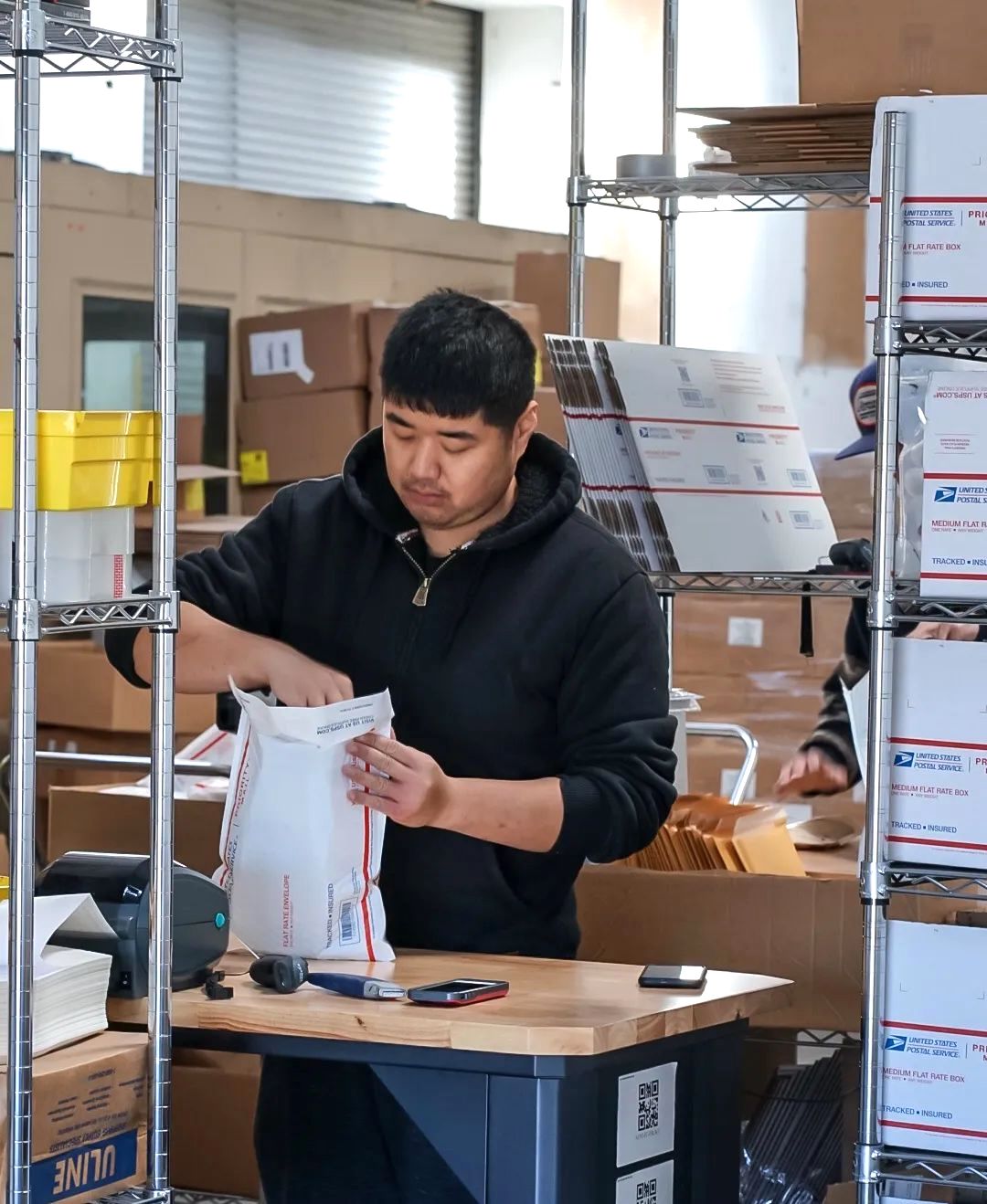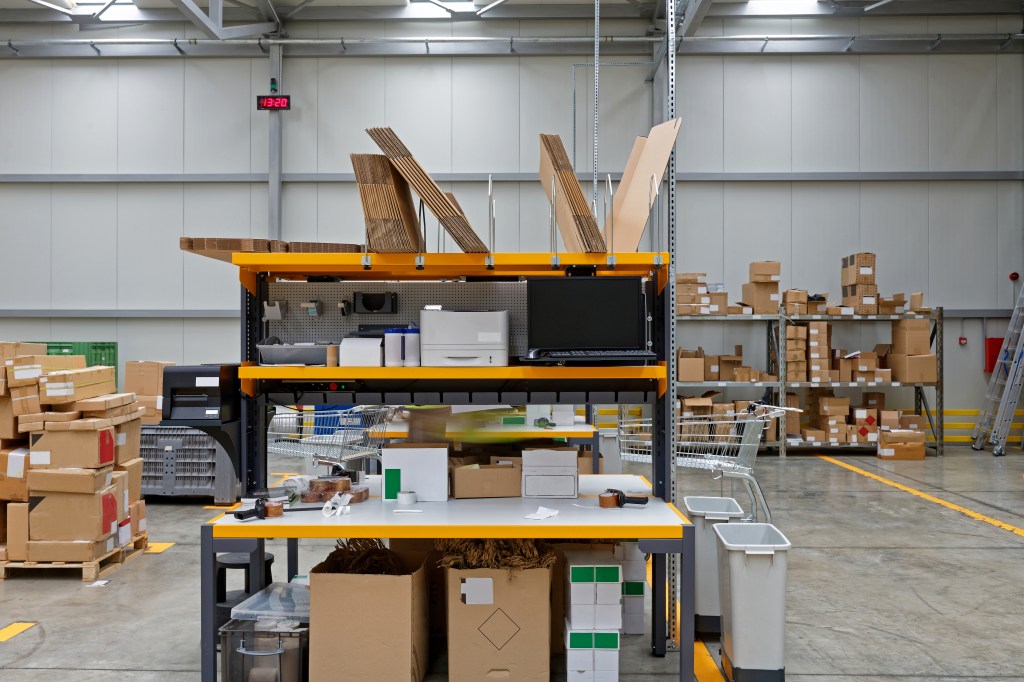If you’ve ever ordered one or two small items online, only to have them arrive in an enormous box, then you know firsthand how important cartonization is.
Shipping items in the wrong-sized packaging isn’t just a waste of space and materials; it’s actually more expensive for the ecommerce brand. To cut shipping costs, protect the products inside, and avoid disgruntled customers, it’s critical for ecommerce businesses to master cartonization and ship every order in the most optimally-sized box or poly mailer.
In this article, we’ll walk through what cartonization is, how cartonization software works, how it benefits ecommerce brands, and how experts like ShipBob leverage it for you.
What is cartonization?
Cartonization is the process of determining the ideal packing configuration and packaging size for the unique combination of items in each order.
Cartonization is a key capability in modern warehouse management systems (WMS), as it:
- Enables ecommerce businesses to speed up their fulfilment operations while optimising their shipping costs and the customer experience.
- Helps brands work toward a more sustainable supply chain.
- Protects goods in transit to minimise damage and costly reshipments.
Let’s define cartonization in ecommerce logistics
Cartonization plays a vital role in the overall ecommerce logistics workflow, enabling a more efficient packing process.
It involves measuring the dimensions of every product that can be shipped out (including width, length, and height), and noting other characteristics that could impact the packing process, such as fragility, shape, or material. Using this data, either through manual calculation or a software’s algorithm, a business determined the optimal packaging type and size for each order’s particular set of items.
In this way, cartonization helps brands avoid sending out items in needlessly-large boxes (which inflates shipping costs and leaves lots of empty space for the item to move around during transit) or unnecessarily small ones (which could break open during shipping and threaten the integrity of the items inside).

How cartonization software works (+ types)
Cartonization software automates the packaging selection process with the help of an advanced algorithm that accounts for a few key variables to select the ideal packaging conditions. These variables include:
- Width
- Length
- Height
- Shape
- Weight
- Material
- Product type (HAZMAT, perishable, etc.)
It then recommends the ideal packing configuration to make the most of available space and ensure items are transported safely. It also ensures cost-efficiency, as it helps reduce packaging waste and minimise additional carrier fees.
Key components of cartonization software
Most cartonization software solutions include the following core functionalities to support packaging optimisation:
- Database containing detailed measurements of every SKU in your inventory
- Library of available carton sizes
- Packing algorithm that’s capable of recommending ideal packing configurations
- Custom packing rules for packaging design customisation
- Quantity-based configurations to effectively handle different order sizes
- Suggestions for appropriate cushioning material like dunnage
- Seamless order data integration to efficiently pull necessary order information
Basic vs. advanced cartonization software
You can find basic cartonization tools that offer simple packing recommendations using fixed parameters. While this satisfies its purpose to some extent, it comes with limitations since it doesn’t account for the complexities associated with mixed item shipments and custom packaging. This makes it suitable for businesses selling just a few types of products and often handle predictable or single-item shipments.
Meanwhile, advanced cartonization tools are capable of handling more complex packing requirements. They leverage AI to make real-time, data-driven packaging decisions to optimise packing efficiency and reduce the number of cartons needed.
As such, advanced cartonization tools can seamlessly handle custom packing requirements and assign multiple SKUs to a single box. They use historical data to create new configurations and constantly optimise your packaging recommendations. This makes them ideal for businesses dealing with a diverse product mix that’s constantly evolving, and for smaller operations as well.
Benefits and applications of cartonization in ecommerce
While it may seem easier or faster to pack products in any container you have on hand, cartonization is better for your brand in the long run. Here are just some of the benefits of cartonization for ecommerce businesses, and why you should take the time to invest in it.
Reduce shipping costs through optimised packaging
Cartonization tools make optimised packaging suggestions to maximise space utilisation in packing, and help you save money in the process. They recommend the perfect box size for each item or order, so that there’s minimal empty space inside each package. This allows you to minimise the use of oversized boxes and effectively reduce dimensional weight.
Cartonization also ensures that you’re fitting multiple items in the same box, so you’re packing orders as tightly as possible and making use of all available space. As a result, you can cut down on packaging costs and avoid the added cost of a split shipment, since you’re not using multiple boxes to ship out the same order. These are highly effective strategies to reduce shipping costs without sacrificing fulfilment speed, which ultimately helps you boost profitability.
“Shipping can be complicated, but our Merchant Success Manager has always helped us find solutions. When we were experiencing issues with DIM weight doubling our shipping costs, I spoke with my Merchant Success Manager about it, he promised to find a solution — and he followed through! ShipBob took time to investigate the issue, and they helped us understand how to reduce DIM weight by reducing packaging weight and size.”
John Greenhalgh, Co-Founder of A Year of Dates
Limit waste and environmental impact
The ecommerce industry is one of the biggest consumers of plastic packaging, with forecasts suggesting that it will produce 4.5 billion pounds of plastic in 2025. In addition to using eco-friendly packaging materials, brands that leverage cartonization further reduce their environmental impact.
With cartonization algorithms recommending optimal packaging configurations, you can fit more orders into a single container, eliminating the need to use another box or polymailer just to ship out all the items in an order. This means you use up fewer materials, which reduces packaging waste and lowers your carbon emissions.
Sharpen up warehouse efficiency
With cartonization software automatically determining the ideal packaging configurations for your orders, it takes the guesswork out of the packing process. This means packers don’t have to rely on tacit knowledge or trial-and-error to decide which items to pack with what, how many items should go in a certain box, which box and packaging materials to use for the order, and more.
This dramatically reduces the time taken to pack orders for shipping, which in turn improves warehouse efficiency. Saving just a couple of minutes for each order could add up to significant time savings across your fulfilment process.
“Regarding warehouse operations, ShipBob provides technology that empowers every warehouse worker. These workers not only receive information on which items to pick and which box to use, but they also have access to a visual aid though a GIF, guiding them on the optimal positioning of items within the box for maximum efficiency.”
Ali Shahid, COO of Our Place
Reduce dimensional weight charges
With shipping couriers often charging for shipments based on dimensional weight, this can make shipping oversized, bulky, or irregularly-shaped products particularly expensive. Cartonization tools can consider the unique shape and size of each product to determine the best way to pack it to reduce dimensional weight and save money.
Improve your customer experience with accurate packaging
Throwing products in any size box or polymailer is the culprit behind many bad unboxing experiences. If the box is too small, the contents could get crushed or break out of the package in transit; if the box is too large, the products could be jostled and broken during shipping.
Cartonization helps you strike the right balance with accurate packaging that prevents shipping damage minus the excess packaging waste. It lets you offer consistent, secure, and branded packaging that ultimately boosts customer satisfaction.
PetLab Co.’s products, for example, came in metal tins and bottles, which were regularly getting dented during shipping. Once PetLab Co. partnered with ShipBob for fulfilment, they worked with the ShipBob team to determine that they needed sturdier boxes and that their box sizes needed to be optimised to reduce rattling in transit.
The team also started mapping out which order combinations would require geami paper or extra dunnage or both to provide additional cushion when shipping out orders. This streamlined the packing process and ensured that orders were safely delivered to their customers in their intended form.
“Before I even committed to moving forward with ShipBob, I actually ordered products from a bunch of brands that I knew were also using ShipBob – and I was so impressed by how each order was packaged with total care and matched the aesthetic of the brand. Everything was just pristine, and I was blown away! Orders sent to our customers have been no different.”
Charlotte Katona, President of Makesy

How ShipBob unlocks cartonization benefits for ecommerce brands
As a leading omnifufillment platform, ShipBob leverages advanced cartonization technology to optimise the packing process and minimise packing mistakes for thousands of ecommerce brands. Here are just some of the ways that ShipBob helps brands save time, money, and effort in fulfilment and beyond.
Advanced cartonization algorithms in ShipBob’s WMS
ShipBob’s WMS features built-in algorithms to optimise the packing process. The data-driven packing workflow draws on your brand’s specific inventory and order data to automatically choose the best packaging for each order, recommending boxes based on size, material, and other factors. That way, your packing team can pack orders to make the most use of space, allowing you to reduce shipping costs.
You can easily determine which items should be packed together, which ones should be packed separately, which packing materials should be used, and more. This significantly speeds up your packing and fulfilment operations, all contributing to faster fulfilment.
“One of my favorite things about ShipBob is the visibility, one example of which is receiving a breakdown of how much it costs to fulfil each of our items. ShipBob uses a Cubiscan, so they have the correct measurements of each product. From there they say, “Based on these dimensions, this specific product mix will be packed in this specific box size. Here is the rate.” So, by that system, we know that one of our bottles is going to cost us let’s say $4 to pick, pack, and ship.”
Cesar Contreras, Head of Supply Chain of Wholesome Goods
Custom packaging solutions for brand consistency
ShipBob’s customisation suite provides you with endless options for optimising your packaging on top of cartonization. You can ship out orders in custom branded packaging to maintain a consistent and premium look and feel for all your orders, and ShipBob’s proprietary box algorithm will always use a triple Cubiscan process to recommend the ideal packaging option based on product dimensions, weights, and your chosen SKU-level packaging preferences.
You can also create ready-to-ship kits containing multiple SKUs to speed up the fulfilment process. You even have the option to add marketing inserts with special promotions or even include customised gift notes with every order. This allows you to create a truly personalised unboxing experience while still making use of our cartonization technology to streamline the process.



Inventory Placement Program for cost-effective shipping
ShipBob’s Inventory Placement Program allows you to strategically position your inventory across various locations in the U.S. This means you can ship out orders from the most convenient location based on proximity and inventory availability and significantly reduce your shipping costs while cutting down transit time.
ShipBob leverages cartonization best practices at every one of its dozens of fulfilment centres across the globe, so no matter where your brand chooses to store inventory and fulfil orders, you have peace of mind knowing your orders are picked, packed, and shipped optimally.
“IPP uses real order data to calculate the ideal distribution and replenishment of inventory across ShipBob’s network to minimise shipping costs and times. My team uses that tool extensively. It helps them understand the potential gains of expanding to different warehouses, and how it could save time and money – it’s been really useful. From there, our team sends all our inventory to one of ShipBob’s receiving hubs, and then ShipBob takes care of distributing those units to regional fulfilment centres across the US for us. Placing inventory closer to customers using IPP has definitely helped lower our shipping costs, but just as importantly, it enhances the customer experience.”
Sergio Tache, Founder and CEO of Dossier
For more information on how ShipBob can help your brand optimise packaging for cost and efficiency, click the button below to get in touch.
Cartonization FAQs
Here are answers to some of the most common questions about cartonization.
How does cartonization enhance your WMS?
Cartonization enhances your WMS by providing automated recommendations on how to pack orders, adding value to your warehouse management and fulfilment operations.
Is cartonization important for mid-market and DTC ecommerce brands?
Cartonization is a crucial process for determining optimal packing configurations to reduce shipping costs en masse and maintain product integrity during shipping. As a result, mid-market and DTC ecommerce brands can keep their costs low, reduce packaging waste, and improve customer satisfaction on a larger scale.
How can ShipBob help with cartonization?
ShipBob uses its own warehouse management system (WMS) at each of our 50+ fulfilment centres globally. This WMS features built-in cartonization algorithms, and leverages triple Cubiscan technology to measure product dimensions. The algorithm then uses this data to recommend the ideal box size and packing configurations for each order.
What factors are considered in cartonization algorithms for optimising packaging?
Cartonization algorithms consider factors like item size, weight, shape, material, and product type to optimise packaging. ShipBob’s cartonization algorithm even considers your chosen SKU-level packaging preferences so you don’t rely on a one-size-fits-all approach.






